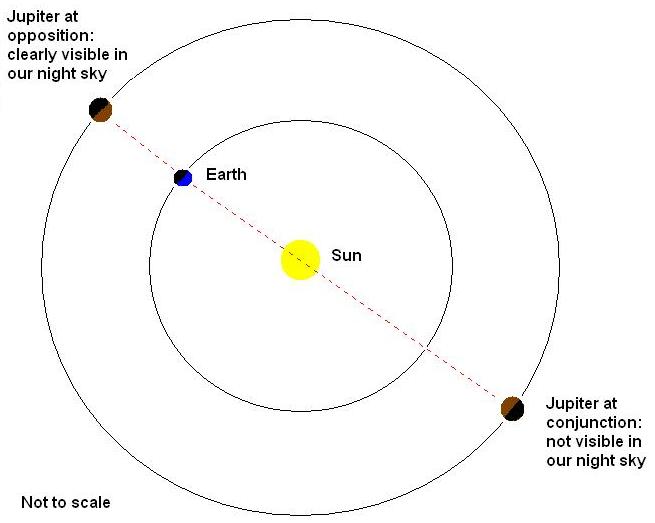
Jupiter is currently in the constellation Gemini (which has two bright stars, Pollux and Castor), found east of Orion. Shown here at 10:00 PM AST on November 24, 2013.(Image source: screenshot from free planetarium software Stellarium: www.stellarium.org)
Jupiter is appearing once again in our evening sky after several months absence.
As Earth and Jupiter both travel around the Sun, Jupiter’s position relative to the Sun changes as viewed from Earth. When Jupiter is on the other side of the Sun from Earth (called conjunction), we are unable to see Jupiter because it appears to be near the Sun from our vantage point (and its reflected light is overwhelmed by the Sun’s light).
 When Jupiter is on the same side of Sun as Earth (called “opposition”), it appears bright and highest in our night sky. As Jupiter nears opposition (which next occurs in January, 2014), it changes from rising just before sunrise to rising earlier in the night. Currently, it’s rising around 8:00 PM and can then be seen in the evening and night sky.
When Jupiter is on the same side of Sun as Earth (called “opposition”), it appears bright and highest in our night sky. As Jupiter nears opposition (which next occurs in January, 2014), it changes from rising just before sunrise to rising earlier in the night. Currently, it’s rising around 8:00 PM and can then be seen in the evening and night sky.
You can easily spot Jupiter with the naked eye – it’s one of the brightest objects in the sky. Look for it east of Orion near two bright stars of the constellation Gemini (as shown in the first image above).
If you have binoculars that you can hold good and steady, you may also be able to spot Jupiter’s four largest moons (called “Galilean” after Galileo, their discoverer) as four bright dots in a line around Jupiter. These moons will switch position from one night to another as they orbit around Jupiter.

Jupiter and its largest moons viewed through binoculars
(Source: http://en.es-static.us/upl/2009/07/jupiter_galilean_moons_300.jpg)

